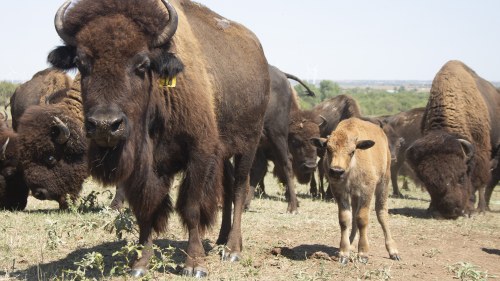Expanding "638" to Enhance Native American Food Sovereignty

Federal agricultural policies must continue expanding to provide greater support for Tribally-led endeavors and choices, including self-determination and self-governance.
In October of 2022, the Chicago Council on Global Affairs is launching a blog series titled, “Stewardship, Sovereignty, and Solutions” that features the voices of guest authors from Indigenous organizations and communities. Recognizing that Indigenous communities around the world disproportionately experience the pressures of climate change, global conflicts, and the pandemic, while simultaneously stewarding 80 percent of the world’s biodiversity, the blog series aims to highlight Indigenous and traditional agricultural practices in the United States and globally. In bringing attention to Indigenous agriculture and foodways, we aim to promote a truly inclusive global food system that recognizes and actively counteracts the oppression of Indigenous peoples.
Native Americans face hunger far too often. Nearly 25 percent of all Native Americans and Alaska Natives rely on some form of federal food assistance monthly to help meet their dietary needs. The coronavirus pandemic created additional barriers, with 49 percent of Native Americans reporting they were food insecure, according to a survey conducted across the United States from March 2020 to April 2021. 1
At the Indigenous Food and Agriculture Initiative (IFAI), it is our mission to enhance the health and wellness of Tribal communities by advancing healthy food systems, fostering diversified economic development, and honoring cultural food traditions. Since IFAI's founding in 2013, we have watched Indian Country food and agriculture policy development and financial investment gain strong momentum as Tribal Nations work to change these negative realities and create a healthier, food secure future. Tribes and Tribal citizens across the country are stepping up and crafting innovative solutions to meet their community’s needs, as they have done since time immemorial. It is vital that federal agricultural policy opportunities continue expanding as well to provide greater support for these Tribally-led endeavors and choices like self-determination and self-governance, specifically through expanding the Indian Self-Determination and Education Assistance Act, also referred to as “638.”
Greater Flexibility in USDA Programs Allow Tribes to Efficiently Tackle Food Sovereignty
Indian Country received more funding through the US Department of Agriculture (USDA) programs than any other federal agency in fiscal year 2022, according to the Office of Management and Budget. Establishing greater flexibilities and alternative modes within USDA programs allows Tribes across Indian Country more opportunities to tackle food access and security in their communities. Extending these options for Tribes throughout USDA programs would help combat many issues at once. It would increase the availability of culturally appropriate, traditional foods as well as support local, Native-produced foods and improve food security, food access, and nutrition. A flourishing local food system not only benefits the community’s health and nutrition, but it also supports economic development and stimulates local economies. Some examples of this include expanding “638” self-determination and self-governance across all USDA programs, expanded cooperative agreement opportunities, and more.
What Is “638”?
The number “638” is short for the Indian Self-Determination and Education Assistance Act, Public Law 93-638, which Congress enacted in 1975. This enabled Tribes to enter contracts with the federal government to receive funding directly to fulfill responsibilities and service delivery of programs once administered by the federal government. Since then, it has also grown to include self-governance or compacting. Self-determination and self-governance reduce federal oversight.
One of the reasons self-determination and self-governance are so effective in Indian Country is that this law provides Tribes the flexibility to deliver programs in the most impactful way that best serves their people’s unique needs. No Tribe or Tribal community is alike. Each has their own unique needs, and entering into self-determination or self-governance opportunities allow Tribes the resources to serve their community more effectively and efficiently than a large-scale, cookie-cutter approach.
However, there remains a tremendous amount of untapped potential for greater “638,” or self-determination and self-governance utilization. Currently, Tribes are only able to enter into self-determination or self-governance agreements with the Indian Health Service and Bureau of Indian Affairs. Much more limited opportunities exist through the Department of Transportation, and most recently with the USDA.
How Does “638” Apply to Indian Country Food and Agriculture?
Until 2018, “638” opportunities did not exist in the realm of food and agriculture. The 2018 Farm Bill included two “638” demonstration projects applied to USDA. One allows Tribes to purchase food products directly for the Food Distribution Program on Indian Reservations (FDPIR). This means Tribes, not the federal government, are making the decision about what foods are available for their people, a strong recognition of Tribal sovereignty. The second “638” opportunity from the 2018 Farm Bill provides Tribes greater authority over forest management through the Tribal Forest Protection Act (TFPA).
However, only eight Tribal governments were able to participate in the initial FDPIR self-determination demonstration project, and only one has entered a TFPA agreement. Many more Tribes have expressed interest in entering into self-determination or self-governance agreements with USDA, but the “638” provisions established through the 2018 Farm Bill are currently temporary and have limited funding opportunities. The current 638 FDPIR projects have prioritized sourcing of traditional, culturally relevant, and/or Tribally produced foods, so these projects represent not only a way to improve food security and health, but also an economic development opportunity for Tribal and local agricultural producers.
Additionally, almost a quarter of all Native households participate in the Supplemental Nutrition Assistance Program (SNAP). Expanding “638” self-determination and self-governance authority for SNAP would allow Tribal governments the ability to shape and administer SNAP in a way that is better suited for their communities and more cost-efficient.
Tribes advocating for the expansion of 638 authority emphasize the importance of including both self-determination and self-governance in USDA programs, so they can better serve their people. However, the decision to enter into these agreements is a decision each Tribe as a sovereign nation must make, and self-determination and self-governance might not be the best option for all Tribes. There are still opportunities for Tribes to have a greater say in how their people are served beyond “638,” including utilizing administrative waivers, alternative funding arrangement for USDA-Natural Resources and Conservation Service programs, cooperative agreements, memorandums of understanding and memorandums of agreement, and more.
Tribes have the solution to hunger in their communities, but they often lack adequate federal support. Expanding “638” self-determination and self-governance opportunities throughout USDA programs, as well as other creative legal authorities like waivers and cooperative agreements, would allow Tribes the choice to be put into the driver’s seat and improve the health and wellness of their people and their economies across Indian Country.
Learn more about IFAI at www.indigenousfoodandag.com.
The Council is a non-profit, independent, and nonpartisan platform. The views expressed by individuals we host are their own, and do not represent institutional positions or views of the Council.
- 1The survey was conducted by the Native American Agriculture Fund, Food Research and Action Center, and the Indigenous Food and Agriculture Initiative.


Related Content
- Embracing Dandelions as Food and Medicine
- Going Beyond Regenerative Agriculture on Tribal Lands
- Expanding "638" to Enhance Native American Food Sovereignty
- Flavors and Culture: Food Systems Through Indigenous Women's Eyes
- A Thanksgiving Legacy: Fighting for Indigenous Food Sovereignty
- Native Food Sovereignty: Strengthening Connection to Culture
- Reconnecting to Indigenous Food Sovereignty Values and Practices
- Embracing Interconnectedness: How Indigenous Foodways Can Save Us